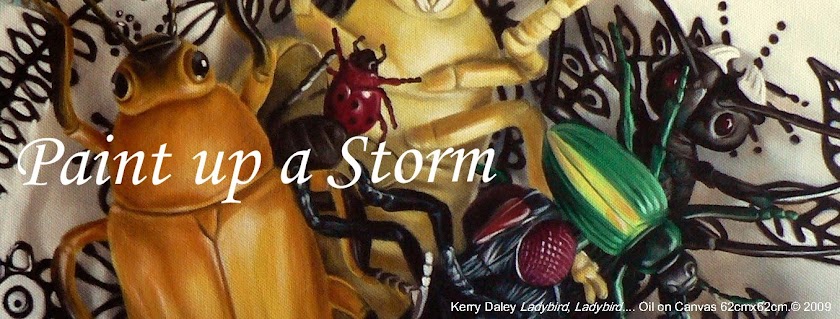In Part 2, I will explain the best ways of cleaning your brushes after working, as well as how to store them correctly. If, of course, you are happy to replace damaged brushes with new ones quite regularly and do not want to take time cleaning, you can skip this section all together and head back to the easel!
Cleaning your brushes after working.
All traces of paint and solvent must be removed from brushes at the end of each painting session and before they are stored. Paint and solvent residue clings to the hairs of a brush that has not been properly cleaned and builds up, making the bristles thick and brittle.
Below left, is a sketch that I have of done to show the parts of a brush (with apologies to Jim Dine on whose work this sketch is loosely based). On the right, I have placed a new brush next to one that has not been well looked after - it is still usable, but you can see how a residue has built up, discolouring the bristles, particularly near the ferrule.
To keep your brushes in good nick, follow these pointers:
- Clean up immediately after each session. Make it a non-negotiable part of the painting process. I like to mull over what I have just done while I am cleaning up, although what usually goes through my head is: "why do you have to use so many brushes!"
- It is best to remove as much paint from the brush as possible before you start to clean, do that by wiping the excess paint off with a rag, or brushing it off on an old telephone book. This works well, because the soiled page can be easily torn out and tossed in the bin.
- When most of the paint has been removed, agitate the brush in water or solvent. Use only water for watercolour brushes and turps or thinners for oil paint. Acrylic paint is also removed with water.
- When agitating your brush, do not bang the bristles on the bottom of the jar, or scrub with them and NEVER leave your brush standing head down for any length of time.
- If you feel that your brushes need soaking, suspend them in the solvent by using a brush washer that holds the brush in a coiled handle. Don't let the solvent touch the handle of the brush, as the wood will swell and the varnish will crack. Brushes should not be left to soak for more than a few hours at a time.
- Thoroughly cleaning your brush means removing all build up of paint, particularly near the ferrule.
- After the solvent stage, comes the soap and water stage. Before I became a reformed brush washer, it never occurred to me to wash my oil painting brushes with soap and water, but it is not the pigment that causes the damage to the brush, but the oil and the solvent residue that can only be removed with soap.
- I have a tiny tub with a piece of laundry soap in it that I take with me to painting lessons and workshops. I find this soap cleans well. It is hard on the hands if you are painting every day, so wear gloves. You could also use a commercial brush cleaner instead of soap.
 |
| Tub of soap for cleaning brushes |
- Wipe your brush across the surface of the soap. Don't scrub. Get a good lather, particularly near the ferrule, and then brush in a circular motion in the palm of your hand. Rinse with warm water and repeat as necessary. I take care to ensure that the ferrule and handle are also free from paint and residue at this stage.
- Use warm, not hot water which can expand the ferrule and cause the hairs to fall out.
- Remove the water from the brush by shaking and flicking. I wipe my brushes dry with a tea towel, but am gentle with the bristles. Remember to dry the handle and ferrule.
- Shape the damp bristles gently with your fingers. If you need to, you can wrap them with a strip of tissue or paper which will contract while drying and reshape the brush. Watercolour brushes can be reshaped by dipping into gum arabic shaping with fingers and leaving to dry until the next painting session. (Remove with water when you next use the brush.)
- Leave your brushes on a flat surface to dry - I put mine on a dry tea towel - at room temperature in an airy environment. Don't expose them to heat. If possible, hang them with the bristles facing downwards to dry.
- If you cannot get the whole washing process done, at least clean your brushes immediately after working to the solvent stage and put in a plastic bag to be properly washed later.
- Don't wash watercolour brushes with anything that you would not use on your own hair.
Storing your brushes
- If you are painting regularly, you can store your brushes upright in jars, if not, it is best to store them flat, in an airtight container, away from dust, mould and insects.
- Make sure that your brushes are absolutely dry before packing them away.
- A bamboo holder is good for storing (and transporting) brushes, as it allows air to circulate freely.
- If you cannot find a bamboo holder, you can improvise with a place mat, as I have. Thread it with elastic to hold the brushes in place, roll up and secure with the elastic and a toggle.
- Cover the ends of the bamboo holder for extended storage time, so that insects do not crawl into your brushes.
If you are kind to your brushes, they will give you many good years of service.




No comments:
Post a Comment